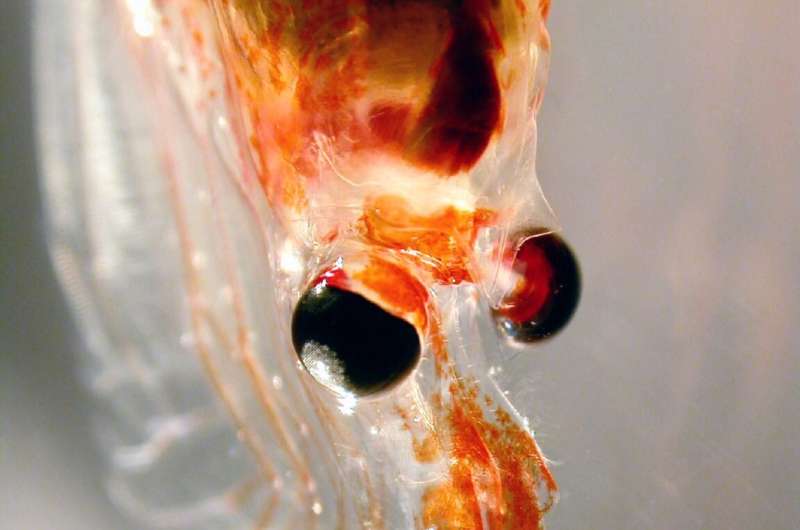This article has been reviewed according to Science X's editorial process and policies. Editors have highlighted the following attributes while ensuring the content's credibility:
fact-checked
peer-reviewed publication
trusted source
proofread
Microplastic found in Antarctic krill and salps

A new study led by researchers at the British Antarctic Survey (BAS) discovered microplastics in krill (Euphausia superba), a small shrimp-like crustacean, and salps (Salpa thompsoni), a gelatinous marine invertebrate. The results are published today (March 29) in the journal Royal Society Open Science.
While Antarctic krill have been observed ingesting microplastics in laboratory settings, the team's findings provide important evidence that these animals, as well as other zooplankton, ingest plastic in their natural environment.
Microplastics are present in the Southern Ocean from the sea surface to seabed. Due to the small size of these particles (<5 mm), Antarctic zooplankton are likely to mistake the plastics for their natural food source. The team focused on two of the most abundant species of Southern Ocean zooplankton: Antarctic krill, and salps. These two species are critical to the diet of much of the Southern Ocean's marine wildlife. Krill is the main food source for whales, penguins, and seals while salps are eaten by some fish and larger marine birds.
Krill and salp samples were collected onboard the research ship RRS James Clark Ross on two research missions off the Northern tip of the Antarctic Peninsula in 2016 and near the island of South Georgia in 2018. Microplastics were extracted from both species with plastic microfibers most common. One of the largest sources of these fibers is shedding from clothing during washing and drying. Around 60% of the krill and salps contained nylon, a microplastic with significant commercial applications in clothing, fishing gear, ropes, and reinforcing car tires.
Lead author Laura Wilkie Johnston, a marine biologist at BAS says, "Evidence of microplastic consumption in two very high abundance species of the Southern Ocean is concerning. Both of these species are an integral part of the Southern Ocean ecosystem, and we don't yet fully understand the impact microplastics will have in this environment."
Co-author Dr. Emily Rowlands, a marine biologist at BAS, says, "We have already seen the harmful effects that plastic ingestion can have on Antarctic zooplankton in the lab. In this study we show how these animals are vulnerable to plastic in their natural habitat. The research is particularly important as it supports laboratory experiments and provides new insights into the amounts and types of plastics krill and salps are exposed to in the Southern Ocean."
The findings underline how sensitive the Antarctic marine ecosystem is to plastic pollution. Due to the short food chains in the Antarctic, transfer of these microplastics from the krill to larger predators such as whales, penguins, and seals is highly likely. Plastic in krill and salps could also negatively impact the Southern Ocean as one of the planets largest carbon sinks.
Co-author Dr. Clara Manno, a pelagic marine ecologist at BAS, and lead scientist on the CUPIDO project, says, "In addition to being important food sources in the Antarctic marine ecosystem, krill and salps play an important role in slowing down climate change. The Southern Ocean is a hugely important carbon sink and these animals play an integral part transferring atmospheric CO2 into the deep oceans. Interactions with microplastics have the potential to interfere with the amount of carbon these organisms can take down and trap in the deep ocean."
More information: Laura Wilkie Johnston et al, Organic or junk food? Microplastic contamination in Antarctic krill and salps, Royal Society Open Science (2023). DOI: 10.1098/rsos.221421
Journal information: Royal Society Open Science
Provided by British Antarctic Survey




















